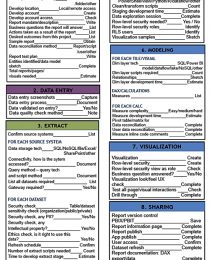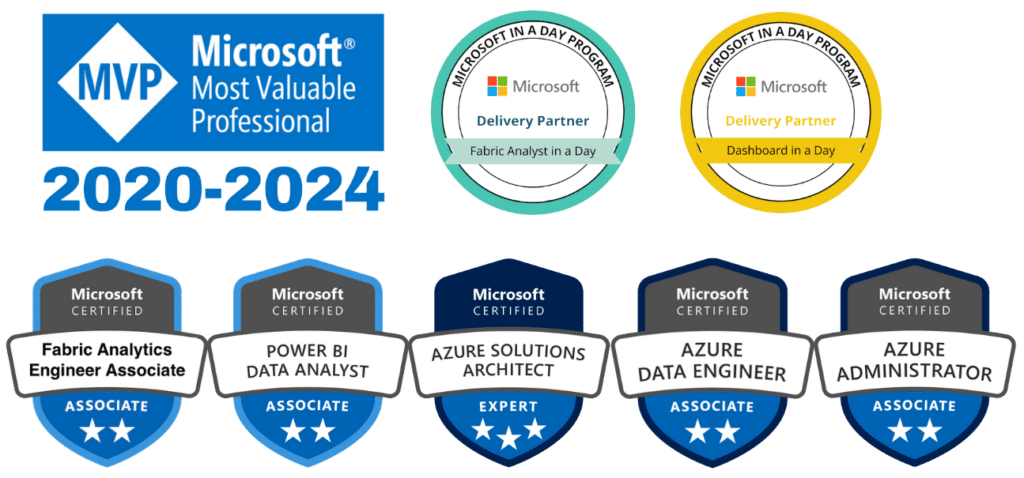Before starting a data reporting project in Power BI, it’s important to undergo a pre-planning stage. This will create clarity on who will be involved in the project, which tools are required, what the desired outcomes are, and how the report should be structured. This article outlines the most useful questions to ask before starting a project in Power BI, and some common mistakes that people make when developing a report.
4 questions to ask before starting a Power BI project
1. Who is associated with the project?
Every data reporting project is a collaborative effort involving multiple people from different levels of an organization. It is crucial to begin by clarifying exactly who will be associated with your project, from development to delivery. You should:
- Create an executive stakeholder profile—The executive stakeholder is the person with the authority to assign resources and make the major decisions about the project’s direction. By completing a profile on them, you can ensure the project is in line with their goals.
- Identify the project audience—By creating a lead user profile, you can gain a deeper understanding of the intended beneficiaries of your project and ensure your report meets their needs. By performing cohort analysis and establishing a user cohort profile, you can tailor your report to a specific user group, ensuring it is useful and relevant. Depending on the experience level of your intended audience in your chosen reporting platform, you may need to focus on usability assistance.
- Identify the project authors—Start by selecting the lead developer in charge of the project and its other authors, including the BI developers, data modellers, data analysts, and business analysts.
2. What is the development environment?
Next you need to consider your development environment. This includes establishing which tools you will use to create your project, where it will be stored, and how it will be accessed. Follow these steps:
- Establish a source repository—First, ensure that you have access to the necessary data to complete your project. Your source data should be gathered in one place and organised in a logical manner. Azure SQL, Azure data lake storage and OneDrive allow you to store data online, making it easily accessible to multiple report builders simultaneously.
- Establish the project location—Decide where your project itself will be developed and saved, be it on local drive software, stored in GitHub or a remote access platform such as PowerBI.com. Create an account if necessary and establish user access controls to maintain security. If you are using Power BI, you should set up separate workspaces for development, testing, and production.
- Determine the tools—Decide which tools will be used to extract, clean, analyse, and present the data. For example, Power BI Desktop, Power BI dataflows or SQL?
3. What are the desired outcomes of your report?
By identifying the project’s audience in Step 1, you’ll already have some insight on the desired outcomes of your report. To get more specific, you should:
- Write a report mandate—A high-level descriptive overview of the report, including its background and purpose.
- List desired outcomes and answers—By focusing on what you hope to achieve as a result of the report, including what business questions the report will answer and what actions it will lead to, you can ensure you collect the relevant data, carry out the right analyses, and deliver an actionable report.
4. How will the report be structured?
Before you dive into creating the report, you should have a clear idea of its structure. To do this you want to “solve the surface” or have a clear design for all the report surfaces that will be exposed to the end user. Here are some tips:
- Obtain a sample report—Look for similar existing reports and use their structure as inspiration. You can also use them to reconcile your report, to ensure that nothing is missed.
- Sketch out your report and the data model—This will help you decide which visuals and interactive filters are needed to answer the key business questions of the project and how many pages the report will likely have.
- Consider how you will test your report—Establish how you will measure the accuracy and functionality of your report along the way, and how the outcomes of your report will be assessed.
Want to create more impactful reports?
Download our pre-flight checklist for use with your next Power BI project.
4 things to avoid in Power BI reporting
Now we’ve covered how to start a Power BI project correctly, let’s take a look at some of the common mistakes to avoid.
1. Don’t try to include everything
When building dashboards and reports for users, it’s vital not to overwhelm them. Break the reports into components and focus on achieving the report’s outcomes without getting carried away. Remember that large data sets, though useful, can slow the loading times, so only use them where they truly add value.
2. Never make guesses
Jumping into data analysis before setting clear goals involves making guesses about the business use case or how your audience will interact with your reports. Avoid this by following the pre-planning steps laid out above.
3. Don’t forget to test your custom visuals
Performance issues in BI reports can result in a lack of user adoption and, in the worst case, the failure of your project. Don’t forget to test your visuals and interactions so you can identify and rectify performance issues before they impact the end user.
4. Don’t skip the key questions
To reiterate their importance, never skip the four key questions listed out above. These guidelines lay the groundwork for a successful data reporting project.
Start planning your Power BI data reporting project today
Now you’re armed with these Power BI best practices and guidelines, you can start planning your data reporting project. Remember to always keep your end user and desired outcomes at the forefront.

